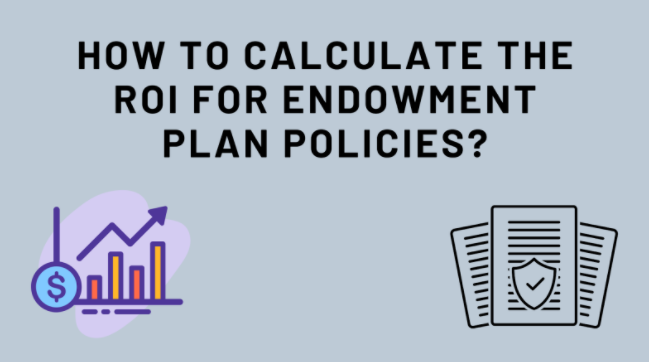
How To Calculate The ROI for Endowment Plan Policies?
Introduction
Naturally, the main idea behind financial planning is to build a wealth corpus that will allow you to live an independent life and a stress-free retirement phase while meeting your wants, future objectives, and aspirations.
However, we must keep in mind that money loses its worth over time. That means that what you can buy for Rs 1000 today will cost you more tomorrow. As a result, you must organise your funds following your future needs. For example, if you plan your funds based on day zero, you will not sustain your future time with that amount. Isn’t this what you don’t want?
Financial Planning: How Do You Do It?
If you think there are multiple tactics to arrive at your destination, the most efficient ones are when you plan your journey from the start and stick to plans as you move forward. You can plan your finances starting with saving money in the bank or start investing in a volatile market with the hope of getting a multi-bagger stock that will change your life forever.
But that’s not what you call a plan; that’s a blind shot you are taking with little or no actualities. The plan consists of strategies and tools getting aligned with the course of time and slowly paving your way to having a definite goal.
The optimum financial plan is based on three pillars: saving, investing, and protection. The saving quotient is covered with what you have as liquid assets. Investing quotient is what your money is in the market and is growing rapidly and ultimately building the corpus. Then there comes the protection prospect; that’s where you should have life insurance policies in your hand.
Having a single source of stable income will not suffice to meet your family’s wants and needs if something happens to you. Therefore, it is critical to obtain insurance coverage to ensure your financial security and sustainability in the future. Thus, insurance plans are an essential asset to include in your financial planning. Endowment plans are popular insurance plan that provides security and recover all premiums paid and the entire corpus after the policy period.
What is an Endowment Life Insurance Policy?
An endowment plan is a blend of life insurance with a savings component. Under this plan, if the life insured is alive until the end of the term, they shall receive the sum assured plus a bonus as a maturity benefit. In addition, if the life insured dies before the plan achieves maturity, the death benefit shall be paid to the chosen beneficiary (by the life insured), just like any other insurance policy.
Endowment policies have higher premiums because they provide higher assured returns than standard insurance policies. Aside from the insurance benefits, an endowment plan serves as financial help for your long-term and short-term goals.
It could be a great investment opportunity. It assists you in amassing funds that can be utilized for a major monetary spend at the end of the policy term, such as your child’s further education, marriage, or home purchase.
ABSLI Assured Savings Plan is one such plan that provides life insurance and savings benefits to safeguard your family members from financial trouble in the case of an accident. It also assists you in amassing a lump sum corpus to fund all of your life ambitions.
How Can Endowment Plans Be Used As An Investment Tool?
You must know the following components to understand how Endowment Plans can serve as an investment component.
Guaranteed Returns includes both a life insurance payout and an investing component. These plans provide guaranteed returns upfront and are thus unaffected by market performance. Guaranteed returns, such as guaranteed additions, are fixed and only distributed upon death or maturity (as applicable).
Bonus: The insurance company typically gives out bonuses based on the assets. An insurance company distributes a share of its profits to its members at the end of each fiscal year. A term life company’s profits or surplus are derived after valuing its financial assets.
Long-Term Financial Planning: Endowment insurance will pay off generously if you hold it for an extended period. The benefits of an insurance endowment plan are only paid out if the policyholder dies or reaches maturity. Surrendering the insurance is not a good choice because you will only receive a low compensation. You must choose an insurance term that will help you save money and achieve your financial goals.
What is the Return on Investment on Life Insurance?
The return on investment or ROI is the total money you get at the end of your investment after minus all the premiums paid until the end of the tenure plus an actual cost of having the plan. The sum remaining is your profit at the end, and when you divide this sum with the total cost, you get a rate of return.
Return on Investing (ROI) = (Maturity Amount – Cost of Investment) / Cost of Investment
As the ROI is measured as a %, it can be easily compared to other investment returns, allowing one to reach various investment possibilities.
How to calculate the ROI of the Endowment Plan?
Calculating the interest rate of life insurance policy and any investment tool is relatively easy from a macro level point of view. You have to simply cut down the premiums and cost of the plan from the total corpus you’ve earned. It gives you a net profit.
Here are a few simple steps that you can follow to calculate the Rate of Interest of your endowment plan:
Step 1: Check basic details of your endowment policy like the tenure of your policy, when it will mature, the premium that needs to be paid, the frequency of premium, which can be monthly, quarterly, annual, or one-time single payment. Do take note of the interest rate the policy is providing when it matures.
Step 2: Keep note of the bonus amount the policy ensures during the course and final payment at the time of policy maturity.
Step 3: To calculate the sum you will receive when the policy ends, it is known as the maturity amount. The maturity amount is calculated by considering the sum assured and any bonuses. It is important to note that this is a ‘positive cash flow’ payment that will be made after the insurance matures in the following policy year.
Step 4: To calculate the profit earned, you must take out the total premiums paid and any other extra cost included in the policy from the maturity amount. The remaining sum, net profit, is then divided by the policy’s total cost to get the interest rate.
Return on Investing (ROI) = (Maturity Amount – Cost of Investment) / Cost of Investment
Seems easy? Let’s jaunt through a quick example to understand the concept. Suppose you have taken an endowment policy for 10 years and for which the premiums needed to be paid Rs 60,000 per annum. Thus the total premium paid for the endowment plan is Rs 6 lakhs. The extra cost of the policy, like processing charges and filing, was Rs. 15,000.
The total maturity amount of the plan can be calculated based on the assured return and the bonuses in the future that are added to the plan. If the assured amount to the above policy is Rs. 6,50,000 and there is a bonus in 5 years gap of Rs 15,000, the total maturity amount you will receive is Rs 6.5 Lakhs plus Rs 30,000, i.e., Rs. 6,80,000.
The profit earned is Rs 6.8 Lakhs – Rs 6.15 Lakhs, which equals Rs 65,000. The return on the profit comes out to be Rs 65,000/Rs 6.15 Lakhs, which is 10.57%.
Conclusion
While calculating the ROI for your life insurance policy, consider the variables attached to the policy when you’ve taken it. These will broadly impact your returns, and thus these calculations will get changed as per needs. It’s now open to you to perform these calculations for yourself! Take out your life insurance policy bond, obtain all necessary paperwork, and calculate your Endowment plan investment returns.



